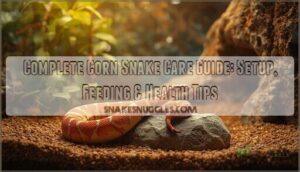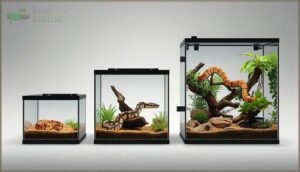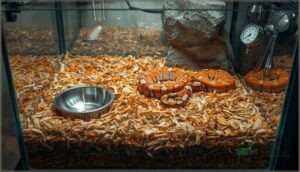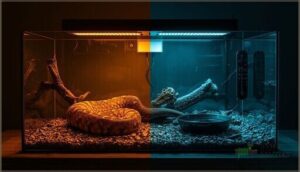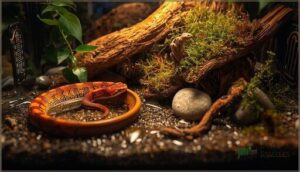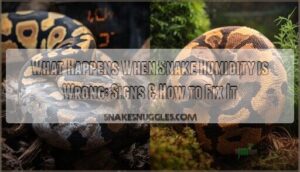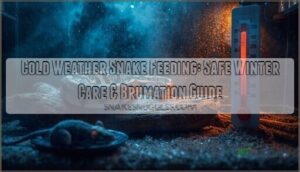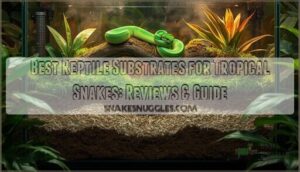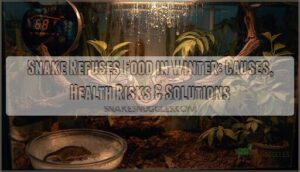This site is supported by our readers. We may earn a commission, at no cost to you, if you purchase through links.
A corn snake won’t bite you for handling it gently—it’s far more likely to curl around your wrist like a living bracelet, flicking its tongue to catalog your scent. This docile temperament, combined with modest space requirements and straightforward feeding routines, explains why Pantherophis guttatus ranks among the most beginner-friendly reptiles in the pet trade.
Yet “easy” doesn’t mean careless—these southeastern natives still need precise temperature gradients, appropriate humidity levels, and whole-prey nutrition to thrive beyond their 10-to-12-year average lifespan. Getting the fundamentals right from day one prevents the respiratory infections, feeding strikes, and shedding complications that plague poorly maintained specimens.
Table Of Contents
- Key Takeaways
- Choosing and Understanding Corn Snakes
- Setting Up a Corn Snake Enclosure
- Feeding and Nutrition Guidelines
- Maintaining Corn Snake Health
- Handling, Socialization, and Breeding
- Frequently Asked Questions (FAQs)
- How do you care for a corn snake?
- How does poor care affect corn snakes?
- Do corn snakes need a hide?
- Do corn snakes need light?
- Are corn snakes hard to care for?
- What do corn snakes need in their tank?
- Do corn snakes need a heat lamp?
- What is the lifespan of a corn snake?
- What not to do with a corn snake?
- How often should you mist a corn snake?
- Conclusion
Key Takeaways
- Corn snakes thrive when their enclosure provides precise temperature gradients (88–92°F warm side, 75–80°F cool), 40–60% humidity, secure hides, and safe substrate like aspen shavings.
- Feeding appropriately sized frozen-thawed rodents every 7–14 days for adults, and 2–3 times weekly for juveniles, keeps your snake healthy and prevents obesity.
- Routine health checks, annual veterinary visits, and attentive monitoring for stress or illness—like wheezing, poor sheds, or appetite loss—are essential for long-term wellbeing.
- Gentle, regular handling builds trust and confidence, while careful socialization and enrichment help your corn snake remain calm and active in captivity.
Choosing and Understanding Corn Snakes
Before you bring home a corn snake, you’ll want to know what you’re working with. These docile constrictors—scientifically known as Pantherophis guttatus—have specific traits that make them ideal for beginners, but understanding their origins, size, and temperament helps you provide better care.
Let’s cover the essentials that’ll set you up for success.
Origin, Natural Habitat, and Wild Behavior
Corn snakes (Pantherophis guttatus) originate from the southeastern United States—stretching from northern Florida through the Carolinas. You’ll find wild populations thriving in diverse habitats, from forested areas to agricultural margins. Here’s what shapes their wildlife and ecology:
- Wild distribution spans warm microclimates with ample cover
- Habitat diversity includes overgrown fields and rocky hillsides
- Snake migration patterns shift between discrete habitat patches
- Geographic variation produces distinct regional color morphs
- Conservation status remains stable in native ranges
These snake species characteristics reflect striking environmental adaptability. Understanding the importance of clear science writing is essential for researching and documenting such species.
Physical Characteristics and Size Range
You can expect a typical adult corn snake to stretch 4 to 5 feet, though some reach 6 feet—larger than many beginners anticipate. Hatchlings start around 10 to 15 inches, then double or triple that length within their first year depending on feeding frequency and genetics.
Snake morphology reveals smooth, glossy scales arranged in distinctive patterns: wild-type specimens display orange or tan ground color with black-edged red blotches running down the dorsal surface, while amelanistic and anerythristic morphs showcase stunning color variations—from ghostly whites to deep crimsons. Scale patterns remain consistent across morphs, maintaining that signature checkered belly.
Body proportions stay slender and elegant throughout life, with a slightly triangular head that becomes more pronounced as adults develop mild neck widening. Growth rates fluctuate based on sex, diet quality, and individual metabolism, but most juveniles hit 12 to 18 inches by their first birthday.
Understanding research methodology is essential for analyzing the growth patterns of corn snakes.
Lifespan, Growth, and Temperament
Beyond size, you’ll need to understand how long your pet snake will live and what personality to expect. Most captive corn snakes reach 10 to 12 years under standard reptile care and maintenance, though outstanding husbandry can push individuals past 15—wild populations rarely exceed 6 to 8 years due to predation.
Growth patterns slow dramatically after year one, while temperament types range from docile hatchlings to occasional stress-responders during feeding or handling.
Popular Morphs and Selecting Healthy Specimens
Once you’re comfortable with growth and care basics, you’ll want to explore color variations. Corn snake morphs number over 60—think Okeetee contrast, Snow purity, or Coral Snow patterns—each governed by morph genetics that dictate breeding outcomes. During snake inspection, prioritize clear eyes, smooth scales, and documented lineage. Reputable breeder ethics include health guarantees, veterinary records, and transparent care protocols. Never settle for lethargy or swelling when selecting pet snakes for superior reptile husbandry.
- Inspect eyes and mouth for discharge or clouding before purchase
- Check body condition—rounded midsection without visible spine protrusion
- Request provenance documentation and any medical history available
- Confirm breeder provides post-purchase care guidelines and support
- Quarantine new specimens for 30 days minimum to monitor health
Setting Up a Corn Snake Enclosure
Creating the right habitat for your corn snake isn’t complicated, but getting the basics right from day one makes a real difference in your snake’s health and behavior. You’ll need to factor in everything from tank size and substrate to temperature zones and hiding spots—each element plays a specific role in mimicking the wooded groves and rocky hillsides these snakes naturally inhabit.
Let’s walk through the core components you’ll need to set up a proper enclosure.
Recommended Tank Size by Age
Your corn snake’s enclosure needs will shift as it grows—think of it as upgrading from a studio apartment to a house. Hatchlings thrive in 20-gallon tanks, while juveniles (3–6 months) need 40 gallons. By one year, aim for 75–125 gallons to enhance habitat conditions and support healthy snake growth rates. Adults flourish in 125–200-gallon setups, ensuring proper temperature gradients and room to explore.
Substrate Types and Cleaning Tips
The right substrate keeps your corn snake healthy and makes cleaning manageable. Aspen shavings and cypress mulch excel at minimizing retained moisture—key for preventing respiratory infections and mold in any bioactive enclosure setup.
- Substrate Safety: Avoid sand-based materials; they pose impaction risks when ingested during feeding
- Cleaning Schedules: Spot-clean daily and replace substrate every 4–6 weeks to manage odor
- Sanitation Practices: Use 70% isopropyl alcohol on surfaces after substrate changes
- Humidity Control: Monitor levels between 40–60% to prevent condensation that fuels mold growth
Hides, Climbing, and Enrichment Essentials
Your snake’s mental well-being hinges on strategic hide placement—position one snug retreat on each end of the thermal gradients to support both security and temperature choice. Incorporate climbing structures like anchored driftwood to satisfy snake agility instincts while rotating enrichment toys every 2–4 weeks.
In bioactive enclosure setups, confirm hides don’t trap humidity or obstruct substrate airflow, preserving ideal temperature and moisture balance.
Heating, Lighting, and Temperature Gradient
You’ll establish healthy thermoregulation by creating a basking zone of 88–92°F at one end and a cool retreat around 80–85°F on the opposite side—this thermal gradient lets your snake self-regulate body temperature after meals or activity.
Heat sources and temperature control demand precision:
- Use under-tank heat mats or ceramic heat lamps controlled by reliable thermostats
- Monitor both zones with infrared thermometers, never exceeding 95°F
- Maintain a 12-hour lighting cycle—UVB lighting systems aren’t required but support natural behavior
- Allow overnight temperatures to drop 5–10°F for physiological rhythm
- Check gradient maintenance weekly to prevent stress-induced illness
Stable heating prevents digestive issues and respiratory infections.
Humidity Control and Safe Water Sources
Humidity levels around 40–60% prevent shedding disasters and respiratory stress. Monitor these levels with a calibrated digital hygrometer, adjusting ventilation systems and substrate moisture as needed. Your enclosure’s temperature and substrate type influence evaporation rates, so weekly checks are essential to maintain balance.
Provide clean tap or filtered water in a shallow, stable dish, avoiding distilled water due to its lack of essential minerals.
| Parameter | Optimal Range/Practice |
|---|---|
| Humidity Levels | 40–60% relative humidity |
| Water Quality | Clean tap/filtered water, changed daily |
| Substrate Moisture | Moist hide with damp sphagnum moss |
| Ventilation Systems | Balanced airflow to prevent mold |
Feeding and Nutrition Guidelines
Corn snakes are carnivores—they need whole prey animals to thrive, not supplements or prepared foods. Getting feeding right means understanding what to offer, how often, and in what size to keep your snake healthy without overdoing it.
Here’s what you need to know about meeting your corn snake’s nutritional needs from hatchling through adulthood.
Dietary Needs and Food Choices
Your corn snake’s diet isn’t complicated, but getting it right matters for long-term digestive health and overall vitality. In captivity, you’ll rely on vertebrate prey—primarily mice or rats—as the nutritional foundation. Here’s what drives proper snake feeding and nutrition in your reptile care routine:
- Prey selection centers on frozen-thawed rodents to minimize injury risk
- Nutrient balance comes naturally from whole-prey items containing organs, bones, and tissue
- Food variety can include occasional chicks, though mice remain the preferred choice
- Digestive health depends on appropriately sized meals that don’t exceed 1.5 times your snake’s widest girth
- Feeding frequency varies by age—we’ll cover that next
Feeding Schedule for Juveniles and Adults
Once you’ve chosen the right prey, timing those meals properly promotes steady growth and nutrient balance without overloading your corn snake’s system.
Juveniles thrive on 2–3 feedings per week during active growth phases, while adults settle into a comfortable rhythm of one meal every 7–14 days.
Adjust feeding frequency during shedding or seasonal slowdowns—growth monitoring and attentive reptile care will guide your schedule.
Prey Sizing and Safe Preparation
Prey measurement starts with your snake’s midsection—select frozen-thawed rodents no wider than that girth to prevent regurgitation or injury during feeding. Thaw prey fully, then warm it to near body temperature for safe handling and ideal digestion.
After your corn snake eats, skip handling for 24–48 hours to avoid stress-related regurgitation, and always wash your hands before and after feeding to maintain proper reptile care.
Preventing Overfeeding and Obesity
Beyond portion control, consistent nutrition planning prevents obesity risks that many keepers overlook. Weekly weight tracking catches early gains, while monthly body condition scoring—running your thumb along the spine—reveals hidden fat deposits before they compromise organ function.
Three feeding strategies support healthy weight management:
- Match prey girth to your snake’s mid-body width, never exceeding it
- Feed juveniles weekly; adults every 10–14 days based on activity level
- Document each meal’s size and your snake’s response to adjust portions proactively
Reptile care and maintenance demands vigilance, not guesswork.
Maintaining Corn Snake Health
Keeping your corn snake healthy means staying one step ahead—spotting problems early, understanding the shedding cycle, and building a relationship with a qualified reptile veterinarian.
You’ll also need to recognize when your snake is stressed and know how to create a calmer environment.
Let’s walk through the essential health considerations that’ll help your corn snake thrive for decades.
Recognizing Common Illnesses and Symptoms
Spotting illness early can mean the difference between a quick recovery and a life-threatening emergency. Respiratory issues—wheezing, mucus around the mouth, open-mouth breathing—signal infection requiring veterinary care.
Skin problems like blistering or lesions, eye infections with cloudiness, metabolic disorders causing lethargy, and neurological signs such as tremors all demand immediate professional assessment to safeguard your snake’s health and wellness.
Shedding Process and Troubleshooting
Shedding cycles reveal your corn snake’s overall reptile health—juveniles shed every 4–6 weeks, adults less frequently. Watch for milky eyes, dull skin, and reduced appetite signaling the start of ecdysis. Humidity control between 50–60% ensures smooth shed removal; inadequate levels cause retained eye caps or stuck skin.
If incomplete shedding occurs:
- Raise enclosure humidity gradually using a hygrometer
- Soak your snake in lukewarm water for 15–20 minutes
- Gently rub retained skin with a damp cloth
- Check basking sites and water availability
Post-shed care includes removing old skin to prevent bacterial growth, maintaining stable temperature gradients, and monitoring body condition through proper animal husbandry practices.
Routine Veterinary Care and Preventative Measures
Annual veterinary checkups form the backbone of preventative care. Your exotics veterinarian will conduct physical exams, fecal screenings for parasites, and weight assessments to catch disease before symptoms appear. Baseline blood panels establish reference values for future health screening.
Environmental audits verify your husbandry fosters reptile health. Keep emergency contacts accessible and maintain detailed medical records for continuity in veterinary medicine—preparedness matters when seconds count.
Signs of Stress and How to Address Them
Recognizing stress signals prevents chronic illness in your corn snake. Watch for defensive strikes, sustained glass surfing, prolonged hiding, and appetite refusal—behaviors indicating environmental enrichment deficiencies or husbandry errors.
Address these issues by verifying humidity management (40-60%), temperature gradients, and adequate hiding spots.
Health monitoring through consistent snake behavior observation facilitates early stress reduction interventions, protecting your reptile’s health and wellness through proactive animal behavior and psychology assessment.
Handling, Socialization, and Breeding
Building a strong bond with your corn snake takes patience and proper technique—especially if you want to handle them confidently or eventually breed them. Knowing when and how to interact with your snake reduces stress for both of you and helps you recognize important behavioral cues.
Whether you’re focused on gentle handling or preparing for breeding season, this section covers the essentials you need to get started.
Safe Handling Techniques and Building Trust
Think of your corn snake as a partner in trust building—every handling session is an opportunity. Start with calm environments and a gentle approach that respects snake behavior; support the body fully and avoid sudden movements.
Treat each handling session as a trust-building opportunity—support your snake’s body fully, move gently, and respect its behavioral cues
Clean hands, predictable timing, and short sessions reduce handling stress while fostering confidence.
Watch for signs like coiling or rapid tongue flicks—these cues guide your snake handling and safety practices toward lasting trust.
Socializing Corn Snakes and Reducing Stress
Consistent socialization techniques—built on gentle, regular interactions—help your corn snake adapt to your presence without triggering defensive animal behavior. Environmental enrichment, like rotating hides and climbing structures, promotes natural exploration while stress reduction follows predictable routines and minimal disruption.
Calming methods include supporting the body during snake handling and safety checks, avoiding loud noises, and respecting rest periods. These practices improve reptile health and wellness through thoughtful pet care and nutrition planning.
Breeding Readiness, Mating, and Egg Care
Breeding your corn snake demands careful preparation—reproductive health hinges on body condition, stable weight, and seasonal cues that trigger natural breeding cycles. Understanding mating behaviors and snake genetics ensures healthier clutches while respecting corn snake biology.
- Assess breeding readiness: Confirm your female has adequate fat reserves and shows no recent illness before introducing a compatible male.
- Monitor mating behaviors: Watch for courtship rituals like tongue-flicking and circling, documenting interactions for future reference.
- Maintain egg incubation conditions: Keep humidity and temperature stable to support embryo development and prevent fungal contamination.
- Practice ethical reptile breeding: Avoid inbreeding and select genetically diverse pairs to strengthen your breeding program.
Hatchling Care and Morph-specific Considerations
After your eggs hatch, you’ll shift focus to neonate care—these fragile youngsters need compact enclosures, stable warmth (82–90°F basking, 75–80°F cool side), and prey sized to match their narrow girth. Hatchling nutrition matters: feed pinky mice every 5–7 days and monitor weight weekly. Certain morphs with reduced melanin show greater light sensitivity, so adjust your reptile enclosure setup accordingly. Minimize handling initially, provide secure hides for environmental enrichment, and watch for respiratory noises or failed sheds that signal trouble.
Understanding morph genetics helps you anticipate hereditary quirks—some color enhancement lines carry subtle health trade-offs, so source hatchlings from breeders who document lineage. Keep corn snake biology front of mind: these neonates grow fast when conditions align, transforming routine pet care and management into rewarding long-term partnerships.
| Care Factor | Standard Morphs | Amelanistic/Reduced Pigment Morphs |
|---|---|---|
| Light Exposure | Moderate UVB optional | Lower intensity; avoid bright UV |
| Shedding Pattern | Uniform, predictable cycles | May require closer humidity monitoring |
| Feeding Frequency | Every 5–7 days | Same, but watch for slower metabolism |
| Handling Acclimation | Start gentle after 2–3 weeks | Extended low-stress period recommended |
Frequently Asked Questions (FAQs)
How do you care for a corn snake?
Caring for your corn snake means creating the right enclosure with proper heating and maintaining humidity around 40-60%.
Additionally, ensure you are feeding appropriately-sized prey weekly and monitoring reptile health checks regularly for ideal snake care.
How does poor care affect corn snakes?
Poor care creates a cascade of health risks—from metabolic issues and respiratory infections to stunted growth and behavioral disorders.
Inadequate enclosure conditions, nutritional deficits, and environmental stress compromise your corn snake’s immune function and overall wellbeing.
Do corn snakes need a hide?
While some keepers skip hides, your corn snake absolutely needs them. Secure retreats on both warm and cool sides reduce snake stress, support thermal gradients, and prevent pacing.
Proper hide placement transforms enclosure design into functional snake habitat.
Do corn snakes need light?
Your corn snake doesn’t require special lighting for health, but a consistent 12-hour photoperiod helps maintain natural rhythms. Ambient lighting works fine—UVB benefits are minimal, and heat lamps should supplement temperature, not light up enclosures constantly.
Are corn snakes hard to care for?
You’ll find these snakes remarkably forgiving—they tolerate beginner mistakes, don’t demand complex care requirements, and thrive on simple feeding challenges.
Their habitat maintenance stays minimal, making them ideal for learning proper snake behavior and handling without significant health risks.
What do corn snakes need in their tank?
Your enclosure needs a thermal gradient (88–92°F warm side, 75–80°F cool), proper humidity levels (40–60%), safe substrate depth, secure hides, climbing branches, and a water dish—all supporting healthy behavior and stress-free care.
Do corn snakes need a heat lamp?
You don’t need a heat lamp—ceramic heat emitters or under-tank heating pads paired with thermostats create safer thermal gradients and temperature control without excessive light, supporting your corn snake’s enclosure humidity and natural behavior.
What is the lifespan of a corn snake?
With proper care, your corn snake can share your life for 15–25 years—some even reach
Longevity tips include consistent temperature gradients, appropriate feeding schedules, and annual veterinary medicine checkups to catch health impacts early.
What not to do with a corn snake?
Don’t grab aggressively, feed oversized prey, or ignore respiratory symptoms. Avoid cedar substrates, extreme temperatures, and handling right after meals—your corn snake thrives when you respect its biology and behavioral limits.
How often should you mist a corn snake?
Most corn snakes thrive without regular misting—your hygrometer should guide decisions, not a fixed schedule. Target 40–60% humidity; mist lightly 24–48 hours before shedding if readings drop below ideal range.
Conclusion
You might worry that corn snake care demands exotic expertise or constant vigilance—it doesn’t. Once you’ve dialed in your thermal gradient, established a feeding rhythm, and learned to read your snake’s body language, maintenance becomes second nature.
This corn snake care guide gives you the species-specific framework to prevent problems before they start, letting you focus less on troubleshooting and more on appreciating a remarkably adaptable companion that asks surprisingly little yet rewards attentive keepers with decades of quiet, coiled companionship.
- https://reptile-database.reptarium.cz/species?genus=Pantherophis&species=guttatus
- https://www.virginiaherpetologicalsociety.com/reptiles/snakes/corn-snake/
- https://journals.biologists.com/jeb/article/218/14/2279/14389/Snake-constriction-rapidly-induces-circulatory
- https://image.petmd.com/files/2024-12/1730300-24-10-PMD-CornSnakeCareSheet.pdf?VersionId=C85M2VWn84MucQ1nerMeMYFQ3gfu0JZS?utm_source=petmd.com&utm_campaign=caresheet&utm_medium=PDF
- https://reptifiles.com/

